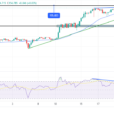Sellers of covered calls seek two objectives: additional income from their stock portfolio and protection from a market decline in the price of their stocks. The call premium helps the option writer to achieve these goals. With the covered call strategy, you can use stocks you already own or you can purchase new shares to sell covered calls on. In either case, you will not be overly concerned about the the price movement of your stocks over a period of time. However, you will only write covered calls on stocks you already own.
We can apply this call writing strategy to dividend paying stocks. You will be getting two sources of income: the dividends and the premium you received from selling the calls. In addition, there is potential for a third source of income if the stock were to increase in price. If we were to allow the stock to be called away, we would receive the strike price in addition to the premium and dividends. This is an outstanding scenario where you can potentially receive three sources of income from one investment!
However, the call writer does not have to remain obligated to deliver the stock. The writer can terminate the obligation if it has not been exercised by purchasing to close an identical option at current premium price. Also, if the option is exercised, you do not have to deliver the original stock as you can purchase new shares to fulfill your delivery obligation.
When you write a covered call, you still own the stock and can receive all dividends paid before the options expire. When you sell options, you begin with an immediate profit rather than an uncertain potential gain. The most you can make is the premium received and the price of the strike minus your cost of the purchase of stock.
There are always opportunities for investors to use options are part of their total investing plan. With careful stock selection and monitoring of your position, selling options can:












Leave A Comment